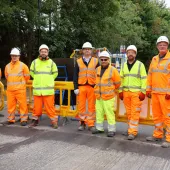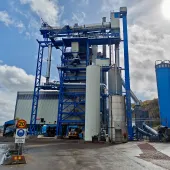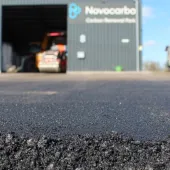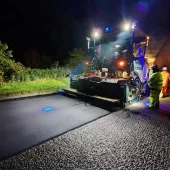Low-Temperature Asphalt

First published in the January 2014 issue of Quarry Management
Taking a temperature check on asphalt carbon savings
By Dr Nizar Ghazireh, senior manager R&D, Lafarge Tarmac
Cutting carbon during the construction and lifecycle of UK infrastructure is a key focus with both the Government’s Construction 2025 Industrial Strategy and recent Infrastructure Carbon Review. With the total UK carbon footprint associated with asphalt manufacture estimated at 786,000 tonnes of CO2 a year – as referenced in the Carbon Trust’s Asphalt Report – reducing the carbon emitted during the construction and maintenance of UK highways remains a key priority for the asphalt industry, as well as the Highways Agency and local authorities. One approach to meeting these significant challenges is through the use of lower-temperature asphalts as an alternative to conventional hot mixtures.
Low-temperature asphalt technology offers numerous benefits for clients, the public, and laying contractors, including reduced possession times and associated traffic management, a safer working environment for road gangs, and reduced project timescales – all of which can translate into potential efficiencies and savings.
What is low-temperature asphalt?
Low-temperature asphalt consists of three types of material, classified by the temperature at which they are mixed and laid (see table below).
| Classification | Temperature |
| Warm | 115-150 degrees C |
| Half warm | 70-100 degrees C |
| Cold | Ambient |
These materials differ from hot asphalt (typically 140°C to 190°C) in that the manufacturing process (and in particular the characteristics of the binder) is modified during mixing. This allows for more efficient production, improves mixture workability and allows effective compaction at a lower temperature. This is achieved by modifying the behaviour of the bitumen through foaming or the use of additives during manufacturing.
Low-temperature asphalt technology has the potential to reduce the embodied carbon of asphalt compared with conventional hot mixes. The principle behind the technology is that lower temperatures are used to manufacture these materials and therefore less energy is required. The quantification of energy savings for these reduced-temperature materials will depend on the manufacturing process used at specific production plants and consistency of demand, therefore can vary from plant to plant even for the same process.
The carbon-reduction advantage
The average carbon footprint for standard hot asphalt manufacture is around 45kg of CO2 per tonne of hot asphalt for binder course materials. When producing the same material at lower temperatures, the saving in carbon footprint can be up to 25%. Therefore, theoretically, if the UK could achieve uptake to the current American level of 30% utilization, it would be possible to realize a potential annual carbon saving of c.58,000 tonnes per annum.
However, it is important that, in the assessment of carbon savings, consideration is given to the whole-life-cycle carbon impact of the hot and lower-temperature asphalts rather than considering absolute manufacturing values in isolation. Properties such as lifespan, durability and potential end-of-use recyclability all play an important role in the whole-life carbon impact of any product, including those made with lower energy and carbon inputs. After all, a material can surely not be considered sustainable if it has a lower embodied CO2, but is not durable or fit for purpose for its application.
It should also be noted that lower-temperature solutions is just one element of the overall approach needed to ensure the sustainability and carbon efficiency of roads, alongside ensuring appropriate specification of materials to deliver durability, flexibility and deformation resistance.
So why, when they offer multiple benefits, are these materials not more widely used in the UK?
Whilst the low-temperature asphalt market share is currently less than 1% of the total UK asphalt market, the US and France have embraced low-temperature asphalts, which now account for approximately 30%* and 10% of their respective annual asphalt demands.
Common barriers to uptake in the UK have included the lack of long-term performance data and concern regarding material costs, which can vary depending on the process adopted, supply coverage and volume demand. Therefore, the uptake of these materials required not only the implementation of specific technologies at production level, but also evidence of their equivalent performance against hot asphalt and production of technical specifications to control their performance.
The project
In 2010, Lafarge Tarmac – in collaboration with the Carbon Trust, Nynas, Atkins, MIRO and TRL (who joined at a later stage) – embarked on a major project aimed at developing the market for low-temperature asphalt in the UK. The research was undertaken as part of the Carbon Trust’s Industrial Energy Efficiency Accelerator (IEEA) initiative.
The project had numerous ambitious objectives, including: to develop low-temperature materials capable of an in-situ performance comparable with conventional hot asphalts; to look at opportunities for CO2 reduction; and to help break down the barriers that have stifled market growth.
Clearly, a key consideration is the considerable capital investment required to install equipment at asphalt plants so that these materials can be manufactured. The level of investment required to retrofit existing asphalt plants with the appropriate equipment to produce low-temperature materials will depend on whether a foaming-bar or an additives system is required. This project initially focused on using the foaming system to produce lower-temperature asphalt, and the team was then tasked with identifying the most appropriate material combinations and laying standards with the aim of developing a blueprint for national specifications.
The project was financed directly by the Carbon Trust and the Regional Growth Fund, utilizing Lafarge Tarmac’s personnel, production and testing facilities. Through a process of laboratory, production and laying trials, the project has successfully demonstrated that it is possible to achieve similar in-situ performance to that experienced using conventional hot mixes and has now produced the TRL Project Report PPR 666. This specification was launched in June 2013 as a draft for consultation and in September 2013 as a final document. Increased uptake of low-temperature asphalts is already being seen associated with increased client confidence stemming from delivery of this document, which now allows procurement of such materials as standard products. Feedback and data from their use will also serve to influence the future development of a European Standard.
A low-temperature asphalt future
This pioneering project has successfully helped to develop a new specification for low-temperature asphalt which can fundamentally change the asphalt industry in the UK.
There is, therefore, a strong case to be made for the use of lower-temperature asphalt which goes beyond carbon savings in isolation, eg reduced possession time and associated traffic-management impacts, less disruption for road users, reduced project timescales, which can be translated into potential efficiency savings.
Initially, the investment in technology and engineering costs associated with manufacturing low-temperature asphalts, together with inconsistent demand, will potentially make material costs slightly higher than conventional asphalts. However, this must be considered in conjunction with the associated on-site savings and efficiencies previously outlined, and as more highways authorities adopt these materials and demand increases, production economies of scale will be realized.
UK policymakers are calling on the construction industry to lower the carbon footprint of infrastructure, and the highways sector has an important role to play in meeting this goal. The drive to cut carbon emissions from the construction and maintenance of highways calls for the industry to take bold steps, embracing existing and beneficial technologies and approaches. The project output highlights the significant part that technical innovation has to play in reducing environmental impacts, while maintaining the same laying and in-situ performance of conventional mixes. Therefore, it is crucial that the asphalt sector seizes upon the benefits of these as yet underutilized technologies, as routine demand will prove beneficial to all – technology and production suppliers, contractors, clients and the public alike.
* From 2007 to 2009, 42 states ran warm-mix asphalt demonstrations and currently 16 states either have made or are currently making warm mix a standard practice. Source: Asphalt Pavement Alliance.
- Subscribe to Quarry Management, the monthly journal for the mineral products industry, to read articles before they appear on Agg-Net








